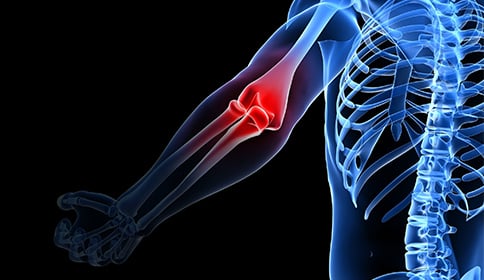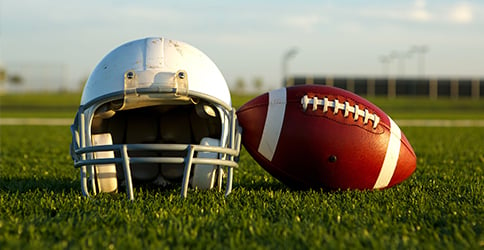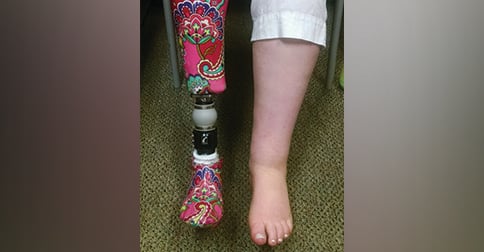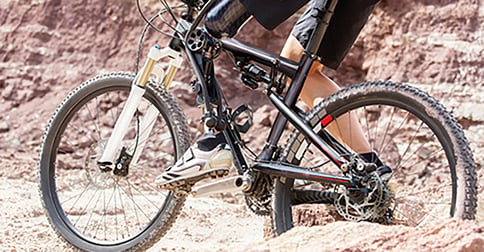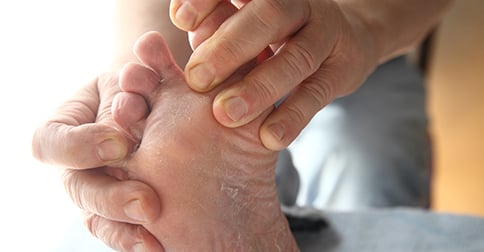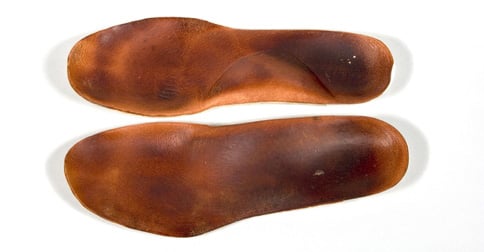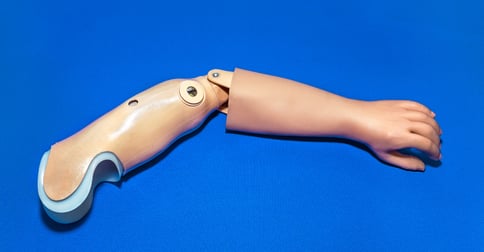Phantom limb pain is a very odd phenomenon. It occurs when a limb that has been amputated or otherwise lost still feels like it is attached to the body – and more often than not, the sensation is excruciating.
So what causes it, and how can you deal with it? Read on to find out!
Where Does the Sensation Come From?
Many scientists believe that the sensation of a phantom limb comes from residual activity in the parts of the Body Image Neuromatrix that were formerly dedicated to that limb. For this reason, treatments for phantom limb pain in the future may involve brain remapping techniques, which could help the brain let go of the lost limb.
Whenever a person experiences a major change in their body, there are corresponding changes in the brain that can also be observed. Additionally, when different, specific areas of the brain incur damage, there is a drastic change in body image and perception. This suggests that the brain and the body are connected in a complex, interactive way, instead of just one localized part of the brain being responsible for one localized part of the body.
What Is the Body Image Neuromatrix?
It is believed that the Body Image Neuromatrix is made up of four parts: regions of the parietal lobe, the somatosensory cortex, and two neural pathways. It seems to be developed in the first eight years of life, as evidenced by the low occurrence of phantom limb pain in children.
Previously, scientists thought that once the Neuromatrix was formed, it could not be changed. This meant that treatment for phantom limb pain involved things like prescription drugs, electric spinal cord stimulation, and acupuncture – all with minimal success. But now, thanks to studies that show how sensory input activates nearby areas of the Penfield map of the motor cortex after the amputation of a limb, it’s thought that the brain is somewhat flexible. That means the Neuromatrix could potentially be reconfigured.
Treatment for Phantom Limb Pain in the Future
With this new knowledge of how the Neuromatrix works, doctors and scientists can focus more on treating the brain rather than the body in order to get rid of phantom limb pain. Once we know exactly how malleable the Neuromatrix is, and once we understand exactly how to change it in order to bring relief to amputees, then we’ll be well on our way to effective treatment for phantom limb pain.
If you have questions about phantom limb pain or any other part of limb loss, contact us today. We are always here to help!
We’ve talked a lot about athletes who have prosthetic devices, and it’s true – they are very inspiring! But since election season is upon us, we thought we’d take a moment to look at some politicians with limb loss who have led the world in spite of their setbacks. Read on!
#1: Ted Kennedy, Jr.
Edward Moore Kennedy, Jr. is the son of U.S. Senator Ted Kennedy and Virginia Joan Bennett. After the discovery of cancer in his right leg in 1973, Kennedy’s leg was amputated. He holds an undergraduate degree from Wesleyan University, a master's degree from Yale University, and a Juris Doctor degree from the University of Connecticut School of Law. An impressive list of accomplishments, indeed!
#2: Daniel Inouye
Daniel Ken Inouye was a recipient of the Medal of Honor. He served as the senior United States Senator from Hawaii until his death in 2012. He was a senator for more than forty years, which is something few senators can claim. After losing his arm in battle, he had to leave behind his plan to become a surgeon, instead returning to college to study political science on the GI Bill.
#3: Max Cleland
Joseph Maxwell Cleland is a former U.S. Senator and a disabled U.S. Army veteran of the Vietnam War. He attained the rank of Captain during his service, and he also received the Silver Star and the Bronze Star for his valorous action in combat. After picking up a grenade he thought had come off his flak jacket, the grenade detonated, shredding one arm and both his legs.
#4: Robert Kerrey
Joseph Robert "Bob" Kerrey served as Governor of Nebraska from 1983 to 1987. He was also the U.S. Senator from Nebraska from 1989 to 2001. Kerrey served as a SEAL in the United States Navy from 1966 to 1969 during the Vietnam War, at which time he lost the lower part of one leg in combat and was awarded the Medal of Honor.
Politicians with Limb Loss Are Just the Beginning...
Here at BioTech, we’re convinced that limb loss doesn’t have to stop you from achieving your dreams. Whether you want to be a politician or a basketball player, the right prosthetic device can help you get there. Contact us today for more information!
You might think it’s impossible for athletes with prosthetic devices to reach the same level of success as their whole-limbed colleagues, but that’s a myth. Limb loss can be overcome on the playing field – and these football players are here to prove it!
#1: Deven Jackson
A few years ago, Deven – now 12 years old – lost both his legs to meningitis. He never wavered in his goal to return to football, even spending 3 hours a week learning to walk and run with his new blades. Plus, he got to meet some of his favorite pro football players as a result of his endurance and positive attitude!
#2: Damon Hodges
As a baby, Damon had twisted feet. Both of them were amputated when he was 2 years old. You wouldn’t think that would make for a very promising football career, but Damon has shown the world otherwise! He’s now playing varsity football for his senior year of high school, and he says that “anything you put your mind to, you can do it.”
#3: Andrew Kittrell
Born with Amniotic Band Syndrome, Andrew lost his left leg below the knee and has a right club foot. The fingers on both of his hands are also affected. All of this resulted in 7 surgeries before Andrew’s 12th birthday. Andrew, now a high school sophomore, doesn’t let any of this stop him – and he thinks it’s pretty funny when his leg comes off during a tackle.
Their Inspiration Is Our Motivation
Here at BioTech, we think people with limb loss are pretty awesome. That’s why we do everything we can to give our patients exceptional service, from expedited fittings to advice on cost and insurance.
Whether you’re looking for prosthetic or orthotic devices, scoliosis braces, or just a friendly face and a positive attitude, BioTech is the place for you. We’ll treat you like family – guaranteed.
Are you ready to experience BioTech? Contact us today!
For a child, the beginning of a new school year typically brings a mixture of excitement and anxiety. What will the teacher be like? Who will be in their class? What will they learn?
These unknowns are challenging enough on their own, but if your child is starting their first school year with a prosthesis, they may need some extra help and support from you. Read on to learn how both of you can handle the situation gracefully and have a fantastic year at school!
Anticipate Lots of Questions
Especially if your child is very young, they are guaranteed to be on the receiving end of a million different questions when they walk into their new classroom. With possible inquiries like, “What is that?” or, “What happened to you?” it’s best to be prepared with short, clear answers that will satisfy the querier without encouraging follow-up questions.
These answers will vary according to each situation, of course, but if you can practice responding to questions with your child before the first day of school, it will make the transition much easier because they will know, more or less, what to expect from their classmates. Kids with prosthetic devices in school are going to attract attention from their peers, so the more prepared your child is, the better they will handle it.
Speak with the Teacher Beforehand
Your child’s biggest advocate will be (or should be, at least) his teacher. Be sure that you have a conversation with the teacher before school starts. Explain the reason for your child’s limb loss, what kind of prosthesis he has, how he is adjusting to it, and any special accommodations he will need.
This is also a good time to ask the teacher to report any bullying to you immediately. While most kids will (hopefully) be tactful, there will likely be others who are not. If your child is the victim of verbal abuse, physical abuse, or any other kind of bullying, you have a right to know about it and to address it with the bully and his/her parents. Your child’s teacher should be able to alert you to any red flags in that area.
Speak with Other Parents
Depending on what kind of response you anticipate from the other students, or what kind of response your child gets during the first week of school, it may be appropriate to reach out to other classroom parents.
This conversation would look very similar to the one you had with your child’s teacher, but you would also want to encourage them to be proactive in shutting down any demeaning talk about your child that they may hear from their own children. (Most parents would do this anyway, but it never hurts to personally encourage them to be on the lookout for inappropriate talk or behavior.)
Reassure Your Child
Most importantly, let your child know that you are here for them! Kids with prosthetic devices in school may feel insecure, scared, or bitter for a multitude of reasons. They need to know that you are in their corner, and that things will get easier every day. The more you can communicate that, the better your child will feel -- and the less it will matter what others say or do.
BioTech Is Here to Help!
When it comes to pediatric prosthetic services, BioTech Limb and Brace is ready and willing to do whatever it takes to give your child the fullest life possible. We are here to guide you every step of the way, from getting your child’s prosthesis fitted to learning how to use it in school. Contact us today!
While limb loss is incredibly difficult for adults to deal with, it can be exponentially harder for kids. Whether the child is processing the loss of his own limb or of a family member’s, he is probably dealing with high levels of shock, grief, and confusion.
Sometimes, the best way to help kids understand limb loss isn’t by telling them directly what’s going on (although open, honest conversations about the situation are vital). Stories and characters can often communicate more effectively than anyone or anything else.
Keep reading for a list of great books that can help kids understand limb loss.
#1: The Tree with No Limbs by Christine Marie Johnson
This book reminds readers that a sudden disability doesn’t make you any less real or any less you. In this story, the tree -- who has no limbs -- finds that he still has a gift inside of him, and that he can still find purpose in his life. (Though it is not listed as such, the reviews state that this is a Christian book.)
#2: Amputeddy Goes Back to School by Jean Boelter and Kate Policani
The first in a series, this story follows Amputeddy as he goes back to school after an accident that resulted in the loss of his leg. Though he worries what the other bears will think of him and whether he’ll still be able to do the things he wants to do, he ultimately learns that he can “still be a regular bear, just like everyone else.”
#3: The Making of My Special Hand: Madison’s Story by Jamee Riggio Heelan
Told from a young girl’s perspective, this story takes the reader through the process of being fitted for a hand prosthesis, which allows the narrator to do things like play with her doll and throw a ball. Though the illustrations seem to show a very young girl, the storyline is appropriate for (and could be comforting for) elementary-aged children, too.
BioTech Can Help Your Child Adjust to Limb Loss
Limb loss can be very difficult for children, but there are steps we can take to ease the transition back into normal life. We understand that children need different types of services than adults, and we are dedicated to giving them the specialized treatment and attention they deserve.
If you have a child with limb loss, please don’t hesitate to contact us for answers to your questions, solutions to your dilemmas, and the kindness of family. We are here for you!
Cycling is a fun, low-impact exercise that can help you rebuild strength and maintain your fitness after losing a leg. But if you’ve had an above or below knee amputation, how do you continue to ride your bike?
Read on for tips!
The Bicycle
One of the most common problems associated with cycling after amputation is that a prosthesis doesn’t stay on a flat pedal very well. Instead, it will slide off, which makes riding a bike very difficult.
As you’re starting to get back into cycling, the best thing to do is to have a flat pedal without clip-ins on the side with your whole leg (for single amputees) while you get used to clipping in on the side with the prosthesis. Sometimes, a clip-in pedal allows for tension adjustment, which will make it harder or easier to unclip. Make sure you set this on the easiest position.
Also, a crank arm shortener may help decrease the degree that your knee has to bend, which can make things a lot more comfortable and efficient for you. Crank arm shorteners allow you to place the pedal in a variety of locations so that you can find the best position and, hopefully, reduce the amount of socket pinch behind the knee or at the hip. You can find a crank arm shortener online or at your local bike shop.
The Prosthesis
Another issue that comes with cycling after amputation is that the heel of your prosthesis may hit the crank arm. If that happens, the first thing to try is asking your prosthetist to help you adjust your alignment when getting on and off the bike.
For an above the knee socket, you can also see about having an older socket cut down to give you more comfort on the bicycle seat. Using a waist belt can help by giving you improved rotation control and suspension.
Some knee prostheses have a “free swing” setting, which can make pedaling much more efficient. Just make sure you know how to change the setting as you get on and off the bike.
Getting On and Off Your Bike
You’ve prepared your bike and your prosthesis -- you’re ready to go! Well, almost. First, make sure you are adept at getting on and off the bike. This needs to be a smooth process that you feel comfortable with before you take off down the road. Have someone spot you until you’ve got the hang of it.
The best way to get on your bike is to swing your prosthetic side (or your weaker side, if you are a double amputee) over the bike and then secure it into the pedal. To get off the bike, set down your sound leg (or your stronger side) first. You’ll have to twist a bit to unclip your prosthesis from the pedal; sometimes it helps to lean the bike over a little after setting your sound foot on the ground.
Once you feel confident getting on and off your bike, you’re ready to take your first ride! Just be careful and exercise good judgment. Start slow, and go out for a short time. You can increase your time and speed little by little until you build up to your desired level. Soon, cycling after amputation will feel natural, and you’ll be spinning down the street whenever you want!
BioTech Can Help You Get There!
Here at BioTech, our passionate, dedicated team is here to help you reach all your athletic goals. We know the possibilities, and we are here to make them your reality! Contact us today for all your prosthetic and orthotic needs.
If you have Type 2 diabetes, you may be well acquainted with the foot pain that often accompanies your condition. Or perhaps your diagnosis is recent enough that you haven’t experienced this particular symptom just yet. Either way, you must take good care of your feet, as your diabetes puts you at risk for foot ulcers, heel spurs, and even amputation.
Like many people, if it took you a while to realize your Type 2 diabetes was there, your smallest nerves and blood vessels may have suffered damage before you began treatment. The result of this is that your feet may feel numb in some places and highly sensitive in others. You may have scratches, cuts, or sores that are slow to heal. But diabetic shoes can protect your feet, and if you have Type 2 diabetes, the right shoes are essential.
Read on to learn what diabetic shoes are and why they’re so important.
How Are Diabetic Shoes Different from Regular Shoes?
Shoes that are made for people with diabetes have a toe box that is higher and wider than regular shoes. The purpose of this is to give your toes a bit more room, because if they rub against each other or against the shoe, they may blister, and they won’t heal as quickly as they did in your pre-diabetic days.
You may think you would know if your toes were blistering, but because of the numbness that comes along with nerve damage from high blood sugar, your toes cannot send your brain a distress signal when they are in pain. A roomier toe box offers extra space for your toes to spread out, shielding them from injury.
Diabetic shoes provide extra support for your arches, ankles, and heels. They also have stabilizers to keep your feet from overpronating (rolling too far inward) or underpronating (not rolling inward enough) while walking, which can cause raw spots that later become sores or blisters.
And finally, diabetic shoes are usually deeper than regular shoes so that you can use an orthotic insert. These inserts can correct an irregular stride, give your heel more cushioning, and offer your arch more support. Many people with Type 2 diabetes use inserts, so the extra depth is vital.
Things to Consider When Shoe Shopping
When you go shopping for a pair of diabetic shoes, make sure they don’t have any inner seams that might irritate your foot and cause a sore or blister. Feel the inside of the shoe to make sure the inner lining is smooth and even.
Slip-ons may be tempting because of the convenience factor, but ultimately, they’re not a good idea. Your feet will swell during the course of the day, and because slip-ons can’t be adjusted, you may have chafing issues in the morning and loss of circulation in the evening. Look for shoes with Velcro or laces instead -- that way, you can adjust them so that they fit properly, no matter the time of day.
Make sure that your shoes have removable insoles. You may need to replace them with prescription or over-the-counter orthotic inserts, so the ability to take out the original insoles is a must.
The time of day that you go shopping is important, too. As mentioned above, your feet tend to swell in the afternoon and evening, so that’s the best time to try on shoes. Even if you plan to buy online because of the lower prices, trying on shoes in person is the best way to make sure you end up with a comfortable, functional pair.
Need Diabetic Shoes? Call BioTech!
Here at BioTech, we offer a wide range of custom orthotics -- including diabetic shoes and custom-molded diabetic inlays. We take your comfort and health seriously, and we won’t rest until you have a great pair of shoes that provide you with an excellent quality of life. Contact us today!
We’ve mentioned before how technology in the field of prosthetics has come a long way, and how it is only gaining speed. When it comes to professional sports, there are some sectors -- like track and field -- that have already realized their prosthetic potential, and there are others -- like basketball -- that are on the verge of doing so.
Pistorius’s Flex Foot Cheetah Blades
Why are we bringing up Oscar Pistorius in a basketball article? Bear with us -- it’ll make sense in a minute.
We know he’s a controversial figure, but if we can look at Oscar Pistorius solely for his athletic ability, we find someone who became a dominant athlete in spite of having both legs amputated as an infant. By the time he was 18 years old, he was a Paralympic gold medal winner in track, and was beginning to compete in races in his native South Africa with people who were not amputees.
How was this possible? How could a man with two amputated legs compete with whole-legged men? According to a study done by the International Association of Athletics Federations (IAAF), "The positive work, or returned energy, from the prosthetic blade is close to three times higher than with the human ankle joint in maximum sprinting."
What This Could Mean for Basketball
Imagine if the technology in Pistorius’s Cheetah blade could be adapted for the basketball court. You could have a durable leg prosthesis with a smart microprocessor that doesn’t get nearly as weary as a natural leg because the returned energy would be so much higher.
And a leg that doesn’t get as weary means a player that doesn’t get as weary -- and that might sound pretty good to the NBA, which is more attuned to the wear and tear of its athletes than ever before.
What Are the Challenges?
As opposed to something like track, which is essentially a single motion sport, there are myriad biomechanical demands when it comes to basketball. Think directional changes, lateral movements, sudden stops and starts, and so on. And that’s not even considering what has to happen for an athlete to shoot the ball or get a rebound -- both of which require a very specific and complicated set of movements in the upper body.
This combination of movements in basketball is the greatest challenge to developing a prosthetic device for the players that would perform at the same level as the Cheetah blade. But the technology is on the horizon, and the science backing it up is advancing quickly.
We’ll never be able to fully replace a natural limb. But it is possible to get close -- and if technology keeps moving the way it has been, the NBA could look very different in just a few years.
BioTech Is Here for All Your Athletic Needs
No matter your lifestyle, BioTech has what you need. We work with each patient one-on-one to get the best fit possible, and we won’t stop until you are completely satisfied. Contact us today for more information!
If you’ve always thought of foot orthotics as a modern invention, think again! Let’s take a look at the captivating story of foot orthotics, from awkward beginnings to modern-day technology.
Historical Predecessors
The first known orthotic foot devices date back almost 2,000 years! Layers of wool were inserted into sandals to relieve foot strain and fatigue, giving the wearer -- who almost certainly spent most of the day on his or her feet -- a bit of extra cushioning.
The first recorded use of arch support occurred in 1865, when Everett H. Dunbar of Bridgewater, Massachusetts, inserted leather “lifts” between the insole and the outsole of his shoe, giving extra support to the arch.
The First True Foot Orthotics
The Whitman Brace, which debuted in 1905, is considered the first true foot orthotic and was introduced to the world by Boston orthopedist Royal Whitman. The device, a stiff metal arch support flanged around the heel and the arch, was popular among orthopedic surgeons because of Whitman’s reputation in the field -- even though it was bulky, heavy, and distorted the wearer’s shoe.
In 1910, Dr. William Scholl (yes, that Dr. Scholl) came out with a much lighter, more flexible metal support called the Foot-Easer. As you may have guessed, millions of pairs sold over the next several years.
Orthotics in the Footwear Industry
The 1920s and 30s brought a wave of “corrective” shoe production. These shoes promised to prevent, correct, or relieve a wide variety of foot issues. Over time, these corrective shoes became a major part of the footwear industry -- and a very lucrative one, too.
The demand for corrective shoes was so high that at one point, there were nearly 1,000 different brands on the market, including 200 “doctor” shoes. The advertising campaigns for these shoes became so outrageous that, in the late 1940s, the Federal Trade Commission was forced to issue cease-and-desist orders. In the wake of this discouragement, the corrective shoe business faded away.
Modern Foot Orthotics
Twenty years later, orthotics gained new traction as materials became lighter, more flexible, and stronger. By the 1970s, when jogging became trendy and athletic footwear was on the upswing, foot orthotics developed even more rapidly. Athletes reported more and more foot and lower limb injuries, and the orthotics industry responded.
Soon, athletic shoes came with orthotic features such as flared heels, contoured sole inserts, and underfoot cushioning. Doctors began specializing in sports medicine, which included orthotics as a standard part of treatment. Today’s orthotics look nothing like the crude Whitman Brace -- a fact that orthotic wearers everywhere have reason to celebrate.
Looking for Foot Orthotics? Call BioTech!
At BioTech, we can help you with everything from custom molded shoes to diabetic inlays. Of course, foot orthotics is just the tip of the iceberg when it comes to the services we offer! Contact us today for all of your prosthetic and orthotic device needs. We are here to serve you!
The field of prosthetic devices has made some pretty incredible leaps and bounds lately. From 3D printed prostheses to devices that connect directly to your brain, prosthetic technology looks pretty promising for the future. Read on!
Civil Beginnings
The use of prosthetic devices first became widespread in the United States during the Civil War. The amputation of a ruined limb was the most efficient way to prevent gangrene, and about 60,000 amputations were done by both sides of the war, with a survival rate of 75%. The demand for prostheses went off the charts after the war had ended -- so much so that the government began offering more money to veterans to pay for their artificial limbs.
After that, from World War I all the way to our present military conflicts, prosthetic devices continued to see increased demand and progressively better technology. New materials were used, and the devices became lighter and more comfortable. Today, prosthetic limbs have reached a new level of function and comfort -- and that progress is only going to continue.
Investing in the Future
Since 2006, the Defense Advanced Research Projects Agency has invested $144 million in prosthetic research for the benefit of the estimated 1,800 U.S. soldiers who have lost a limb. Some of that money went into an invention by Hugh Herr -- a bionic ankle for people who have lost one or both legs below the knee. This device actually propels its wearer forward as they walk, which helps them conserve and regain lost energy.
Herr hopes that one day, users can simply attach their device to a bone via a titanium rod, merging the device with their body almost seamlessly.
Seamless Integration
Herr isn’t the only one with high hopes for this kind of thing. Michael McLoughlin, who works as the engineer leading the development of advanced prosthetics at Johns Hopkins University, works to create a more streamlined integration of prosthetic devices with human bodies. The Johns Hopkins lab has built a Modular Prosthetic Limb (MPL), an arm-and-hand device that has 26 joints controlled by 17 separate motors and functions almost exactly like a natural limb.
McLoughlin is looking for a way to speed up the device’s connection with the nervous system -- possibly connecting it directly to the brain. Fortunately for him (and us), researchers at Brown University actually did this when they hooked up a robotic arm directly to the brain of a 58-year-old quadriplegic named Cathy Hutchinson. As evidenced on the video results, Cathy was able to pick up a bottle and drink from it.
BioTech Has the Best in Prosthesis Technology
Here at BioTech, we love to watch the world of prosthetic devices progress to such exciting heights! From the BioTech BioSystem to carbon technology, we’re passionate about providing the latest and greatest devices for your needs. Contact us today!
